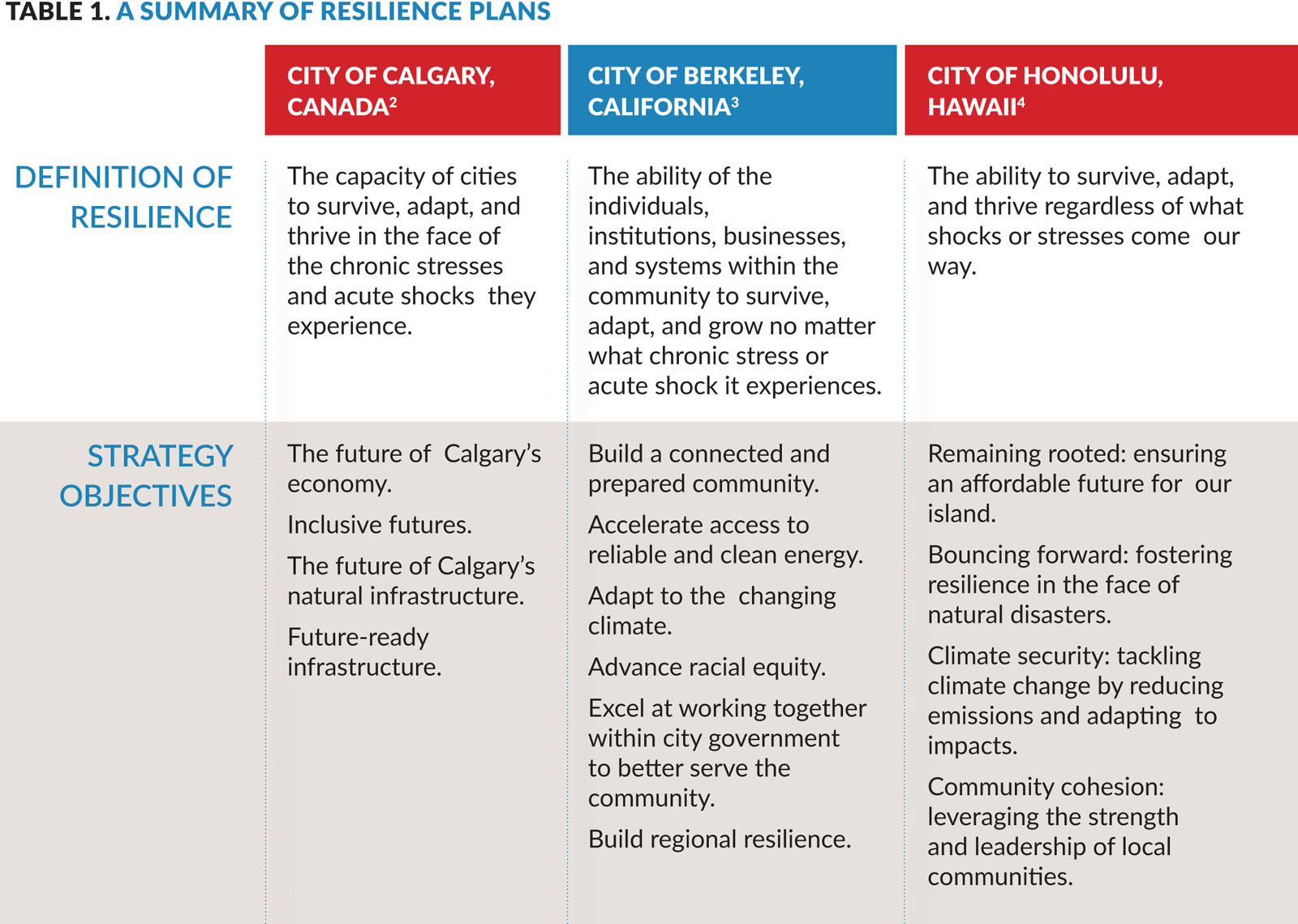
BY KEL WANG AND MICHAEL SAMBIR
What does the future hold? It depends on where you stand and the information you have at hand. Even if we’re not certain about what will happen, we can anticipate with confidence any issues and conditions that may arise and plan for them.
This is one of the most important skills that you, as a manager, can develop in your organization. In this article, we present how this approach, proactive planning, can help communities deal with issues over time.
Recently, we have noticed the trend of developing resilience plans (see Table 1). A resilience plan allows a community to build “the capacity to recover quickly from difficulties.”1 While each plan is unique with different objectives, they all share similar steps in development—steps that take into account local context and external trends and factors, and are excellent examples of proactive planning.

Using this approach is where art meets science. Proactive planning has a scientific basis because of its research component that relies on a rigorous and data-driven method to gain an in-depth understanding of issues and come up with solutions. It also demonstrates the art of planning because the solution to local issues lies at the sweet spot between community expectations, buy-in, and readiness.
To help undertake this type of planning approach, we have come up with a simple formula (Figure 1). Now, let’s lift the hood and look at the engine of what can drive responsive change in your community.
First Element: Local
The first element in the formula is local, meaning the context of the issue you are experiencing. It includes community expectations, buy-in, and readiness so it is community-specific. One of the best ways to collect this information is to host conversations directly in the community with residents and key stakeholders. This can be done through various methods such as public engagement sessions, focus groups/workshops, interviews, and surveys.
Each method has its advantages and disadvantages. Public engagement sessions allow for broad participation while focus groups, workshops, and interviews tend to be topic- or theme-specific. Telephone or online surveys allow for broad participation. They can be topic-focused, but the overall participation rate is usually lower than the other methods, so the information may not fully represent the community’s views.
In the three plans identified in this article, a combination of methods were used. Depending on your budget and needs, a combination of these will help you collect the insight and perceptions that are critical for understanding the issues within your community.
Second Element: External
While you are gaining an understanding of the local impact of an issue, it is equally important to be mindful of the best practices and emerging trends and factors in the field. That is why the second element—external—matters. This will require a systematic process to conduct research and scan outside the local community.
A common analysis technique is PESTEL: political, economic, social, technological, environmental, and legal trends and factors. It is a framework to identify opportunities and challenges in these specific domains and understand implications related to the local issue. In Calgary’s plan, for example, the team had a look at issues (or stresses and shocks, to use the language of resilience) in PESTEL areas and identified economic uncertainty as the number-one stress. Local feedback paired with research information and statistics allowed the project team to identify the strategic objective: the future of Calgary’s economy. The PESTEL approach used in various communities will yield various results.
The Role of Catalyst
As a manager, your role is to be the catalyst for building your organization’s proactive planning competency to support this type of work. To ensure that your city or county is prepared to deal with these sorts of issues, we advocate using the proactive planning formula to articulate expectations, delegate ownership of the work, and provide resources. The greatest challenge in delivering the plan is preserving the knowledge and skills that are developed as you respond to these arising situations.
The three plans we highlight are projects with a start and an end date. When the work was done, the project closed and staff likely moved on to a different challenge. This is great! Community expectations were met and the issue was addressed.
However, without a strong commitment from leaders, the knowledge gained may be difficult to retain and apply again in the future. Yet this type of work never seems to go away.

We know community needs and expectations are constantly shifting and evolving and the proactive planning approach offers a flexible and timely response to these types of issues. And this is why it is necessary for the manager to function as a catalyst, ensuring this competency is developed and retained.
Addressing Ongoing Change
Proactive planning can help you address any pressing issue your community currently faces. But it requires all three elements of the formula—local, external, and catalyst—to arrive at a solution. The formula won’t work if any elements are missing.
In your role as the catalyst, you won’t contribute directly to the work, yet you will build the competency that will activate the solution. If you only see the issue by itself, inevitably, it becomes a project of the month, the quarter, or the year: work that happens at a point in time, for a limited time.
Change is constant and we believe the need to address change in communities is ongoing. That is why it is necessary, as we illustrate in Figure 1, to have the competency available in your organization (catalyst) to support this type of work through engaging the community to understand the issue (local) and conducting research (external) for best practices and emerging trends and factors.

KEL WANG is the corporate performance lead, city of Edmonton, Canada (kel.wang@edmonton.ca).

ENDNOTES AND REFERENCES
1 Source: Google Dictionary.
2 https://www.calgary.ca/CS/Pages/Calgary-Resilience.aspx
3 https://www.cityofberkeley.info/Resilience/
4 https://www.resilientoahu.org/resilience-strategy
New, Reduced Membership Dues
A new, reduced dues rate is available for CAOs/ACAOs, along with additional discounts for those in smaller communities, has been implemented. Learn more and be sure to join or renew today!
